| Dvorets Sporta |
| 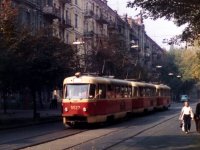 | At the end of the 1940s — beginning of the 1950s
the tram line along Ulitsa Saksaganskogo was extended one block east
to Shota Rustaveli, and then further on towards Pechersk.
Here a 3-car train 5527+5528+5529 goes down Shota Rustaveli,
having just left its Dvorets Sporta terminus. Trams ran here until
the fall of 1997. Note how empty the roadway is: some pedestrians actually
walk on it!
[Gordon Stewart, 05.10.1985] |
|
| 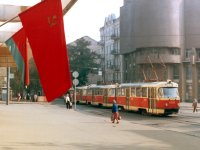 | The intersection of Shota Rustaveli and
Rognedinskaya. Another three-car train, headed by 6008, has just
completed its around-the-block loop.
The two flags adorning the building on the left are
those of the USSR (pure red) and the Ukrainian SSR (red and blue).
The reason is the Constitution Day, which at that time
was celebrated on 7 October.
[Gordon Stewart, 07.10.1985] |
|
| 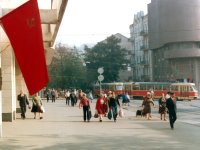 | The same spot viewed from almost the same point.
A two-car train, 5199+5200, serving route 27, is turning
onto Rognedinskaya Ulitsa.
[Gordon Stewart, 07.10.1985] |
|
| 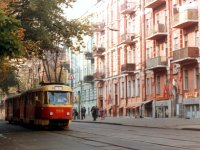 | A two-car train on route 1 is approaching its
final stop at Dvorets Sporta. A few typical attributes of the late Soviet epoch are visible in this picture: two soda water machines near the passageway entrance, a half-basement in the neighboring building carrying the Liquor Products sign (the notorious anti-alcohol campaign has just begun, thus liquor is only being sold starting at 14:00, by which time huge lines would form before the stores), and, again, the red and red-and-blue USSR and UkrSSR flags.
[Gordon Stewart, 07.10.1985] |
|
| 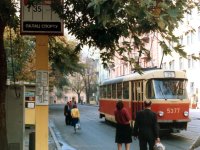 | Approaching the same stop is a two-door car 5377 belonging to the Darnitsa depot, which is on route 35 from Vokzal to Bereznyaki (for that route, this stop is not a terminus). A few interesting details include: the stop sign with a list of routes and a scheme of those routes attached to the pole; a soda water machine; a yellow tram ticket booth; an advertisement of the Polish movie Va Banque; on the right, a few payphone booths, which were painted in almost the same colors as the trams.
[Gordon Stewart, 07.10.1985] |
|
| 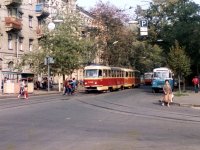 | Once again, the intersection of Shota Rustaveli and Rognedinskaya, viewed from a point next to the building which then housed the Puppet Theatre; now, as before the revolution of October 1917, this is the main Kiev synagogue. A two-car train headed by 5338 sits at the terminus of route 27, ready to get underway, make a left turn, and proceed towards Pechersk and the left bank.
[Gordon Stewart, 05.10.1985] |
|
| 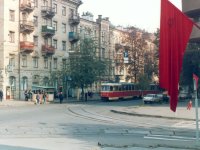 | The same spot viewed from the porch of the Puppet Theatre building. One more two-car train, headed by 5371, is on route 27. The abundance of red flags is augmented by a child dressed in colors that match the flags quite well... Another indispensable Soviet attribute is a line by the vegetable kiosk, to the left of the tram stop.
[Gordon Stewart, 07.10.1985] |
|
| 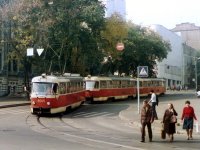 | The intersection of Esplanadnaya (called Kuybysheva back then) and Rognedinskaya. A three-car train 6005+6006+6007 on route 1 is turning from the latter onto the former. The Puppet Theatre building is visible on the left, behind the trees and the street lamp pole.
Behind the tram one can see the intersection of Rognedinskaya and Shota Rustaveli. A Volga GAZ-24 is partially visible on the right.
[Gordon Stewart, 05.10.1985] |
|
| Pechersk |
| 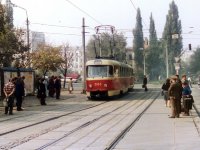 | The next stop after Dvorets Sporta, going towards Pechersk, was called "Bolnitsa Oktyabrskoy Revolyutsii". This train is going along route 27 towards the left bank of the Dnieper. Behind the tram, in the background, one can see a building dating back to the end of the XIX — beginning of the XX century, built by a well-known Kiev mecenate Lazar Brodsky (who used to be one of the principal shareholders of Kiev tram) as a shelter for poor Jews. In the Soviet time, it housed medical offices, and in the summer of 1996, during a reconstruction, it was torn down — in particular, because it hindered tram service... and then, just a little more than two years later, tram service here was discontinued.
[Gordon Stewart, 05.10.1985] |
|
| 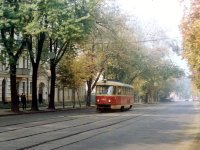 | Pechersk, the first block of Ulitsa Yanvarskogo Vosstaniya. The tram line here dated back to the beginning of the XX century; trams used to run to the Lavra, then to the neighborhood of Zverinets, then towards Most Patona and the left bank. The single car 5415, devoid of passengers and belonging to the Shevchenko depot (whereas both routes that ran here, 27 and 35, were served out of Darnitsa depot at the time), must be on a service or test run. In the far background one can discern a new Skoda 14Tr trolleybus on route 20 towards Lavra.
[Gordon Stewart, 05.10.1985] |
|
| 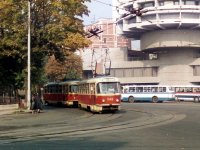 | Ploschad Slavy, where the tram line used to turn from Yanvarskogo Vosstaniya onto Suvorova; the two-car train headed by 5148, belonging to the Darnitsa depot, is entering this turn. On the right, the viewer's eye is attracted by the cosmic shape of the Salyut hotel, opened just a year earlier; lots and lots of LAZ buses, in city and tourist versions, are stationed next to the hotel.
[Gordon Stewart, 05.10.1985] |
|
| 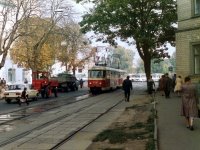 | Ulitsa Suvorova, which used to be one-way for cars but two-way for trams. The two-car train is on route 27, and going in the opposite direction is a Kharkov-manufactured tractor. Visible on the right is the corner of the Kiev Automobile and Road Institute (nowadays National Transportation University) building; before the revolution, it housed the Fifth Gymnasium. In 1998, tram service on this line was discontinued, despite three (!) reconstructions on the same line, which were carried out in the preceding three years. In 1999—2000, the tram tracks were lifted in several stages.
[Gordon Stewart, 05.10.1985] |
|
| Prospekt Vossoedineniya — Leningradskaya Ploschad — Komsomolsky |
| 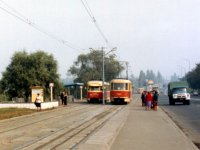 | The photo gallery is concluded with a set of pictures from the left bank of the Dnieper. The first one has been made on Prospekt Vossoedineniya, near the Bereznyaki stop. A T-2 on route 32, going from DVRZ to Podol, is approaching the photographer. A two-door T-3 is proceeding in the opposite direction, towards Leningradskaya Ploschad. Yet another tram is coming down from the viaduct over the railway line. Approximately at the same spot where this last car is, there was a branching towards the Ulitsa Entuziastov terminus of routes 34 and 35.
[Gordon Stewart, 06.10.1985] |
|
| 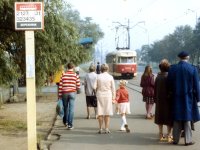 | The same stop, Bereznyaki, from a different angle and a closer distance. In the foreground, on the left, one can see the yellow pole that the stop sign is attached to; the name of the stop, route numbers, and a route map (on the pole itself) are all visible. An old T-2 tram, 5043, is approaching the stop, also on route—32 from DVRZ to Podol. This particular car happens to be the only one that has been preserved to this day (although not in a working condition as of now).
[Gordon Stewart, 06.10.1985] |
|
| 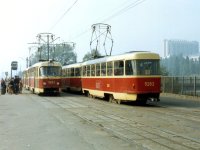 | This picture was taken at the next stop, Bulvar Davydova, which is closer to the Dnieper. Approaching us is a train of two three-door cars headed by 5933, serving route 31 from Podol to Rembaza; going along the same route in the opposite direction is a train consisting of two-door cars. In the far background, in the fog, one can barely discern the Paton Bridge approach. To the right of the tram is a pedestrian bridge over the Rusanovka channel, at the far end of which Ulitsa Entuziastov and the beginning of Bulvar Davydova. There is also the high-rise building of the luxurious (by Soviet standards) Slavutich hotel.
[Gordon Stewart, 06.10.1985] |
|
| 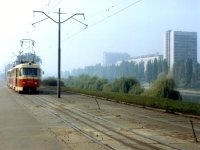 | A stretch of track between the two stops depicted in the previous frames. Yet another two-car train, with 5953 at the head, is going from Podol to Voskresenka on route 21. The Bulvar Davydova stop is to the left of the train, in the background. The Rusanovka channel, the buildings along Ulitsa Entuziastov, ending with the Slavutich hotel and including the two high buildings on either side of the entrance onto Bulvar Davydova, are all visible on the right.
[Gordon Stewart, 06.10.1985] |
|
| 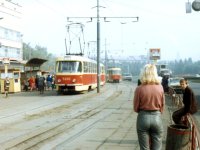 | This and the next photo have been taken at the Darnitsky
Univermag stop, where Prospekt Vossoedineniya flows into Leningradskaya Ploschad.
On the left, closer to the Univermag (department store), there is a train of
two-door cars from the Krasin depot, headed by 5260, which is going to Podol on
route 31. Around the stop there are a few yellow ticket kiosks. On the roadway
to the right from the tracks once can see a two-axle half-trailer loaded with
containers, a parked Volga taxi, a Skoda-LIAZ truck with a refrigerator
half-trailer, and a RAF-2203 minibus. The young woman on the right is
dressed according to the fashion of the time...
[Gordon Stewart, 06.10.1985] |
|
| 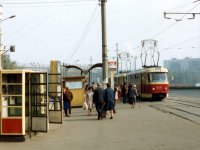 | The same spot viewed from the opposite side of the tram tracks. A train with 5371 at the head, on route 27, is approaching the stop. On the left, closer to the viewer, there are three red-and-yellow payphone booths; behind them is a glass-paned neighborhood map. To the right of the tram is Leningradskaya Ploschad. In the middle of the square, on a flowerbed, there is a grandiose installation featuring the state emblems of all the Soviet republics, also visible in the preceding photo.
[Gordon Stewart, 06.10.1985] |
|
| 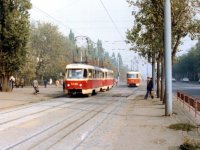 | This picture was taken a little further east, away from the Dnieper, at the crossing of Prospekt Gagarina, Ulitsa Stroiteley, and Ulitsa Vladimira Sosyury. The two-car train on route 27, out of Darnitsa Depot, is crossing Stroiteley. In the left part of the frame there are the phone booths we have already seen, and a blue grocery kiosk, behind which there is an Ikarus 260 or 280. A few soldiers are crossing the street right in front of the bus.
[Gordon Stewart, 06.10.1985] |
|
| 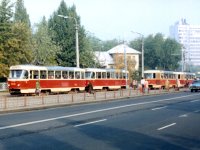 | Further east along Prospekt Gagarina, the line reached the crossing with Krasnotkatskaya and Krasnogvardeyskaya. Depicted here are two trains passing through the Krasnotkatskaya stop, and another one is emerging from Krasnogvardeyskaya, in the background on the right.
In 2004, tram tracks were removed from the Paton Bridge, Prospekt Vossoedineniya, and most of Prospekt Gagarina. As a result, the Kiev tram system ended up being broken into two parts, separated by the Dnieper river. Trams nowadays circumvent Prospekt Gagarina via an industrial zone near the Darnitsa depot.
[Gordon Stewart, 06.10.1985] |
|
| 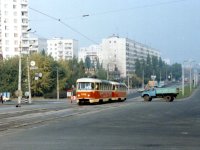 | The next photo was taken at the Komsomolskaya (Chernigovskaya) Metro station, leaving the viaduct over that station and descending onto Komsomolskaya Ulitsa (nowadays Miropolskaya). A train of two well-painted and washed T-3 cars from the first batch, headed by 5059, is approaching the station. Behind it, one can see two ZiL-130 trucks crossing the tram tracks. In the background there is an imported long-haul Volvo truck, belonging to Sovtransavto, then the monopolist on the international trucking market in the USSR. The buildings behind the trees on the left form the Komsomolsky (initially called Severno-Brovarskoy) residential area.
[Gordon Stewart, 06.10.1985] |
|
| 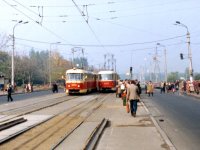 | The tram line runs further north along Komsomolskaya, into the neighborhood of Voskresenka. The last picture of the gallery was made supposedly at the Ulitsa Aleksandra Boychenko stop. Quite a few trams are passing by, the first train being the one we already saw before, with 5953 at the head. To the right from the tram line, behind the people crossing the roadway, one can see two passenger cars — a Moskvich from the 1970s, going away from the viewer, and a parked Zhiguli (Lada) VAZ-2102. In the background, the tram line and the roadway are lost in a sea of greenery...
[Gordon Stewart, 06.10.1985] |
|